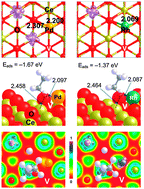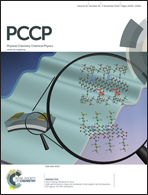A DFT + U computational study on stoichiometric and oxygen deficient M–CeO2 systems (M = Pd1, Rh1, Rh10, Pd10 and Rh4Pd6)†
Abstract
Molecular and dissociative adsorption processes of ethanol on stoichiometric and O-defected CeO2(111) surfaces alone as well as in the presence of one metal atom (Pd or Rh) are studied using spin-polarized density functional theory (DFT) with the GGA + U method (Ueff = 5.0 eV). Dissociative adsorption (onto ethoxides) is slightly more stable than molecular adsorption onto stoichiometric CeO2(111). The creation of surface oxygen vacancies further stabilizes both modes. In the case of ethoxide adsorbed onto a Ce3+ cation, adjacent to the oxygen vacancy, charge transfer to a nearest Ce4+ cation occurs. In addition, the interactions of Pd1 (or Rh1), Pd10 (or Rh10) as well as of a bimetal cluster (Rh4Pd6) with perfect and O-defected CeO2(111) surfaces have been studied. From spin density calculations, it was found that the addition of metal changes the oxidation state of Ce4+ cations. The magnetic moment at the neighboring Rh or Pd induces a charge transfer to Ce4+ cations (i.e. Ce4+ (4f0) that becomes Ce3+ (4f1)) and consequently M is oxidized to Pdδ+ (or Rhδ+). Similar to the atomic metal adsorption, Rh10 has a stronger adsorption energy on the perfect surface than Pd10 (Eads = −6.49 and −5.75 eV, respectively), while that of Rh4Pd6 was in between (Eads = −6.00 eV). The effect of one metal atom on the adsorption of ethanol was also studied. The presence of the metal further stabilized the adsorption energy of ethanol/ethoxide in its bridging configuration. The creation of an oxygen vacancy nearest the metal resulted in considerable stabilization of ethoxides (Eads = −1.67 eV in the case of Pd) compared to those found on the O-defected CeO2(111) surface alone (Eads = −0.85 eV).


 Please wait while we load your content...
Please wait while we load your content...